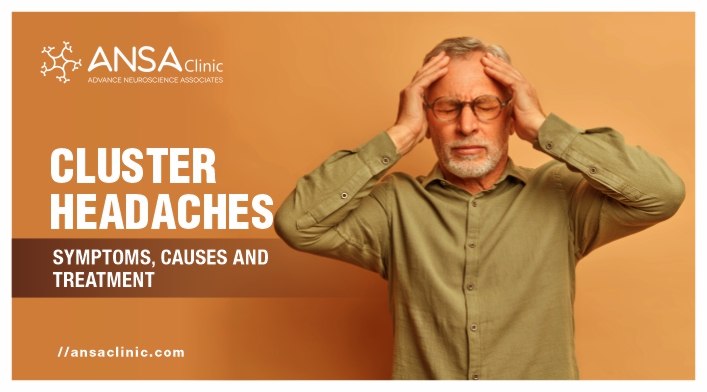Cluster headache is a primary headache syndrome like migraine, but it has different characteristics and different treatment than a Migraine. Cluster headaches generally occur in cluster periods or cycles of pain and are one of the most painful types of headaches.
Symptoms and Signs
As its name suggests, there are frequent bouts/pain attacks in clusters for a few weeks or months. During this period, the patient had pain followed by the remission period in which the patient remains pain-free. These bouts/ attacks last for 15 min to 2 hours, 1-8 times a day. Pain is mostly on one side, pulsatile pain in or around the eye later spreads to the head. Pain is associated with tearing from the eye, redness of the eye, flushing/redness or pallor of the face, running nose on the affected side, occasional drooping of the eyelid, and restlessness.
A cluster headache commonly awakens you in the middle of the night with intense pain. The patient cannot even sleep or lie on the bed. It mostly occurs at the same time of day. There are no trigger factors like migraine but during cluster periods alcohol and smoking can worsen headaches.
Diagnosing Cluster Headaches
Men aged 20-50 years affected the majority. Cluster headache is misdiagnosed as sinusitis, rhinitis, or ophthalmological conditions, but it will not be controlled by the treatment for the same. It is diagnosed by mainly clinical features as described above and rules out other serious causes.
Neurological examination and also MRI brain to check for any infection, tumors, aneurysm, or AV malformation.
When to seek emergency
Change in pattern or severity of headache, sudden severe excruciating pain, or associated with unconsciousness, fever, weakness, or convulsions.
Cluster Headaches Treatment
Treatment is available to abort the acute attack and prevent attacks in the cluster period.
- Acute headache treatment – Oxygen inhalation through a nebulizer mask, Injectable or inhalational triptans, or ergotamine and local anesthetic can be used.
- Preventive medication – Short course of steroids along with calcium channel blockers like verapamil, lithium, or noninvasive vagal nerve stimulation can be used in cluster periods.
Also, surgical therapy is available but rarely used like sphenopalatine ganglion stimulation or Occipital nerve stimulation.
Cluster headaches can be a debilitating condition, but with the right understanding and management techniques, it is possible to find relief. By recognizing the symptoms, undergoing a proper diagnosis, and seeking appropriate treatment, individuals can manage their cluster headaches and improve their quality of life. We hope this guide has provided valuable information and insights for anyone dealing with this condition. If you are experiencing frequent and severe headaches, it is important to speak with your healthcare provider for a proper evaluation and personalized treatment plan Or schedule a consultation with our top neurologists in Ahmedabad.

